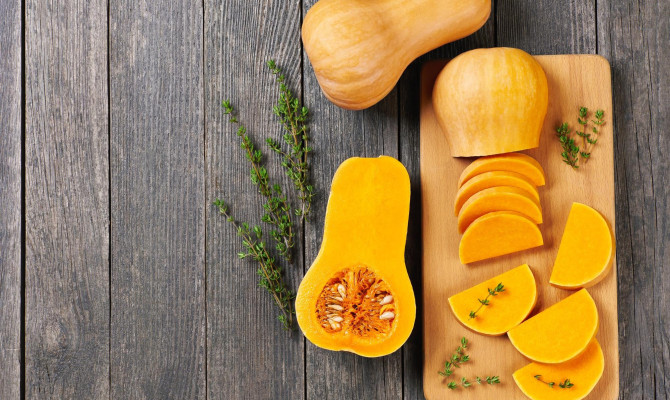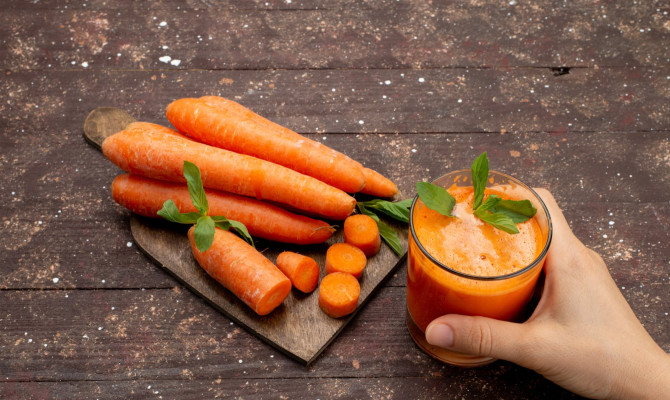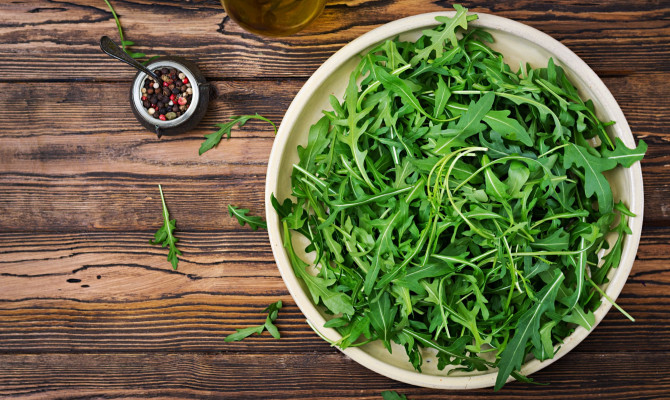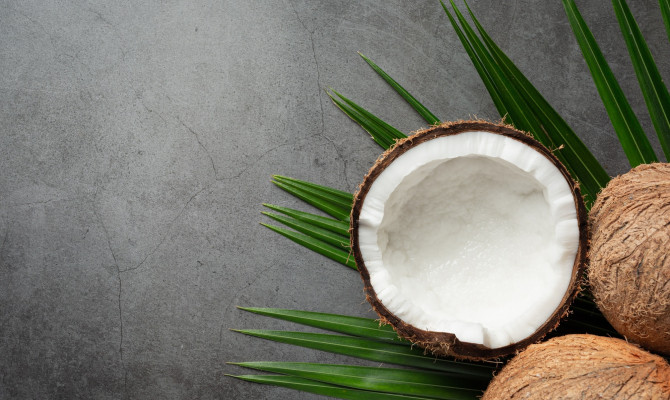All about Nutritious Kale

- Kale
- 22 Aug 2023
Overview
What is Kale?
Kale, a vegetable in the cruciferous family (Brassicaceae), has gained enormous popularity as a superfood in recent years due to its incredible nutritional value and multiple health advantages. Var. acephala of Brassica oleracea L. is its scientific name.1Overview| Researched based study from Sciencedirect.com This leafy green powerhouse’s versatility and flavor have won over health-conscious people and cuisine connoisseurs.
The different facets of Kale are covered in this article, including its nutritional value, health advantages, how to pick it and incorporate it into meals, safety issues, and precautions.
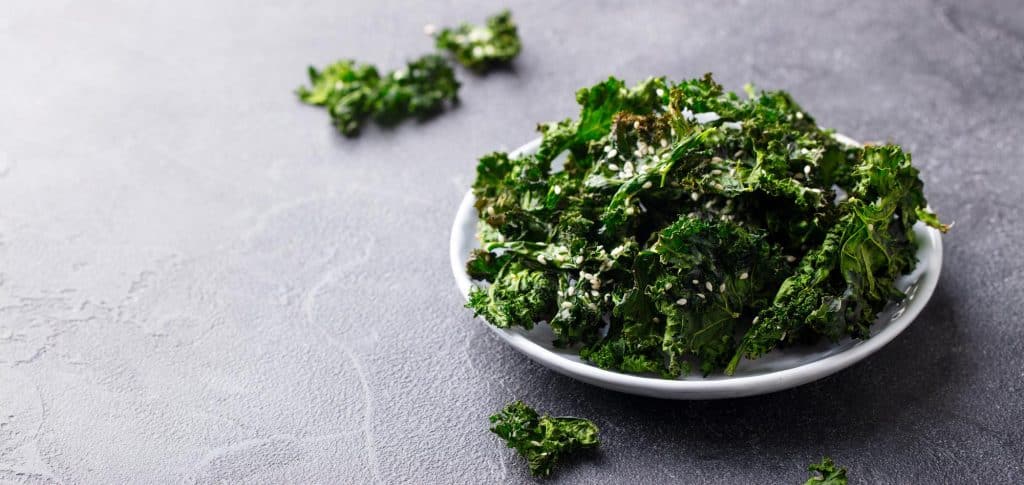
Nutrition
Nutrition in Kale
One cup (118 grams) of frozen, cooked, boiled, drained Kale, without salt, may contain approximately:
- Water – 106 g
- Calories – 42 Kcal
- Carbohydrates – 6.3 g (2% of DV)
- Protein – 3.5 g (7% of DV)
- Fat – 1.4 g (2% of DV)
- Fiber – 4.7g (17% of DV)2Nutrition| Researched based study from Usda.gov
Minerals
- Potassium – 170 mg (4% of DV)
- Calcium – 177 mg (14% of DV)
- Magnesium – 29.5 mg (7% of DV)
- Phosphorus – 49.6 mg (4% of DV)
- Sodium – 18.9 mg (1% of DV)
- Iron – 0.991 mg (6% of DV)
- Zinc – 0.319 mg (3% of DV)
- Manganese – 0.64 mg (28% of DV)
- Copper – 0.079 mg (9% of DV)
- Selenium – 1.06 µg (2% of DV)
Vitamins
- Vitamin C – 21 mg (23% of DV)
- Niacin – 0.539 mg (3% of DV)
- Vitamin B-6 – 0.074 mg (4% of DV)
- Riboflavin – 0.165 mg (13% of DV)
- Pantothenic acid – 0.201 mg (4% of DV)
- Thiamin – 0.074 mg (6% of DV)
- Vitamin K – 493 µg (412% of DV)
- Vitamin A – 172 µg (19% of DV)
- Beta carotene – 2040 µg
- Alpha carotene – 11.8 µg
- Folate – 76.7 µg (19% of DV) 3Nutrition| Researched based study from Nutritionalvalue.org
- Lutein + Zeaxanthin – 5880 µg
- Vitamin E (alpha-tocopherol) – 1.9 mg (13% of DV)
(Note: mg – milligrams, g – grams, µg – micrograms, % Daily Value (DV) – How much of a nutrient in a plate of food contributes to a daily diet.)
Health benefits
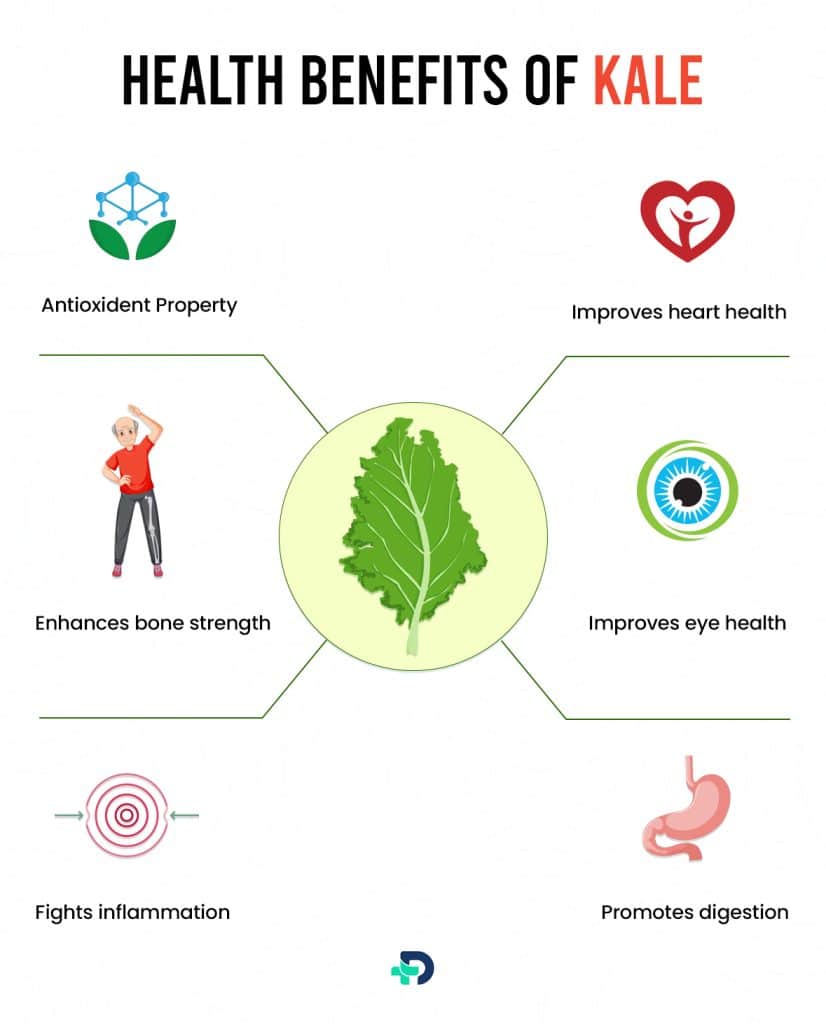
Health benefits of Kale
Kale is an excellent supplement to any balanced diet because it is linked to several health advantages as follows:
- Antioxidant property
- Improves heart health
- Enhances bone strength
- Improves eye health
- Fights inflammation
- Promotes digestion
- Detoxification
- Manages weight
Antioxidant property
- Among the antioxidants present in Kale are beta-carotene, flavonoids, polyphenols, and vitamin C.4Health benefits| Researched based study from Nlm.nih.gov
- They reduce oxidative stress and decrease the risk of developing chronic illnesses like heart disease and cancer by scavenging the body’s harmful free radicals.
Improves heart health
- Kale’s potassium, fiber, and antioxidant content all support heart health.2Health benefits| Researched based study from Usda.gov
- Fiber helps lower LDL cholesterol levels 5Health benefits| Researched based study from Nlm.nih.gov , and potassium helps keep blood pressure healthy, reducing the risk of heart disease.6Health benefits| Researched based study from Heart.org
Enhances bone strength
- Kale enhances bone health and reduces the incidence of osteoporosis and fractures due to its high calcium and vitamin K content.7Health benefits| Researched based study from Nih.gov ,8Health benefits| Researched based study from Nlm.nih.gov
Improves eye health
- Kale contains vitamins A, B, C, E, zinc, lutein, and Zeaxanthin, maintaining good vision and protecting against age-related macular degeneration and cataracts.9Health benefits| Researched based study from Nlm.nih.gov
Fights inflammation
- Kale has a high concentration of antioxidants and omega-3 fatty acids, which can decrease inflammation and may be helpful for those with inflammatory diseases.10Health benefits| Researched based study from Nlm.nih.gov
Promotes digestion
- Kale promotes regularity, the maintenance of a healthy digestive tract, and the prevention of constipation because of its high fiber and water content.11Health benefits| Researched based study from Mayoclinic.org
Helps in Detoxification
- Sulfur compounds found in Kale enhance liver health and facilitate the body’s detoxification procedures.12Health benefits| Researched based study from Nlm.nih.gov
Manages weight
- Kale is an excellent food for weight management since it keeps you full without adding extra calories, thanks to its low-calorie, high-fiber, and water content.11Health benefits| Researched based study from Mayoclinic.org
Selection
How to choose them?
Kale’s flavor and nutritional value will be maximized using fresh, high-quality varieties. When selecting kale, the following factors should be taken into account:
- Look for bright, deep green leaves free of browning or fading.13Selection| Researched based study from Foodprint.org
- A wilted kale leaf or slimy area has likely been spoiled, so avoid it.
- Kale leaves should be stored in the refrigerator in a plastic bag without being washed to preserve their freshness.
- Kale may be adequately kept and stored for up to five days.
- Eating Kale as soon as you can after buying it is advised for optimum flavor and nutritional value.
Culinary uses
Culinary uses of Kale
The healthiest way to consume Kale is raw in salads. If cooking is necessary, moderate steaming can help preserve the food’s nutrients and lessen its bitterness compared to raw form.
However, here are some typical culinary uses:
- Salads – In hearty salads, Kale may be the star element. Rub the leaves with lemon juice and olive oil before adding Kale to a salad to make them softer.
- Smoothies – Your morning smoothie’s nutritious value can be increased by including a handful of Kale without sacrificing flavor.
- Stir-fries and sauteed dishes – Kale can be added to stir-fries or sautéed with garlic and oil for a fast and nutritious side meal.
- Kale chips – baked kale chips seasoned with salt and olive oil provide a tasty and healthy snack.
- Soups and Stews – Kale boosts the nutritional value and gives soups and stews a robust texture.
Vs. Spinach
Kale vs. Spinach
Although both Kale and spinach are common leafy greens, they differ in several ways, including flavor, texture, nutritional value, and culinary applications:
- Taste – Spinach has a gentler, sweeter flavor than Kale, which makes it more appealing to specific individuals, especially when cooked. When eaten uncooked, Kale comes with a slightly bitter taste.
- Texture – While spinach has a soft feel, Kale has a chewy one that most perceives as stronger and more fibrous than other leafy greens.
- Nutritional content – Compared to spinach, Kale is higher in vitamins A, C, and K, whereas spinach contains noticeably more folate 14Vs Spinach| Researched based study from Clevelandclinic.org . While Kale offers more calcium and potassium, spinach is a more significant source of iron.
- Culinary uses – Kale may be used in salads, soups, smoothies, stir-fries, and chips, but spinach is more adaptable. It can be used in a variety of recipes, including omelets, pasta dishes, salads, and sandwiches.
Side effects
Kale Side effects
Consuming Kale in moderate quantity is generally safe. However, when consumed in excess, it may cause some side effects like:
- Bloating
- Gas
- Digestion problems
Additionally, in rare cases, it can cause allergic reactions like
- Itchy skin
- Swelling of lips, throat, and tongue
- Watery eyes
- Hives
- Dizziness
- Runny nose
- Diarrhea
Precautions
Precautions
Even though Kale is a vegetable rich in nutrients and has several health benefits, it is essential to be aware of any possible concerns and safety measures:
- Thyroid problems – Goitrogen-containing substances found in cruciferous vegetables, including Kale, may interfere with thyroid function, especially in those with hypothyroidism, an underactive thyroid. Raw kale use should be limited for those with thyroid issues, and heating it may be an option to minimize the goitrogen level.
- Kidney stones – Oxalates, which can prevent calcium from being absorbed and perhaps lead to kidney stone formation, are present in Kale and other leafy greens. Kale should be used in moderation, and calcium should come from different sources if you have a history of kidney stones or are at risk for them.13Precautions| Researched based study from Foodprint.org
- Blood Thinners and Vitamin K – Warfarin and other blood-thinning drugs may be affected by Kale’s high vitamin K content. To find out how much Kale or other foods high in vitamin K you can include in your diet if you take blood-thinning medication, speak with your doctor.15Precautions| Researched based study from Mayoclinichealthsystem.org
Takeaway
Takeaway
Kale is one of the most nutrient-dense vegetables, with an astounding assortment of vitamins, minerals, and antioxidants. You may benefit from Kale’s many health advantages and enjoy its mouthwatering flavor by regularly including it in your diet. However, a diet emphasizing a single food should be replaced with various nutritious meals.
Any feedback on this article?
 This Articles content was accurate
This Articles content was accurate Very Informative Article
Very Informative Article I have a question or a comment
I have a question or a comment
 This article contains inaccurate content
This article contains inaccurate content This article was not helpful
This article was not helpful I have a question or a comment
I have a question or a comment
We appreciate your helpful feedback!
Checkout our social pages
References
-
Science Direct
Kale: Brassica oleracea L. var. acephala | Overview
-
U.S. DEPARTMENT OF AGRICULTURE
Kale, frozen, cooked, boiled, drained, without salt | Nutrition
-
NutritionValue.org
Kale, without salt, drained, boiled, cooked | Nutrition
-
National Library of Medicine
Improving the Health-Benefits of Kales (Brassica oleracea L. var. acephala DC) through the Application of Controlled Abiotic Stresses: A Review | Benefits
-
National Library of Medicine
Cholesterol-lowering effects of dietary fiber: a meta-analysis | Benefits
-
American Heart Association
How Potassium Can Help Control High Blood Pressure | Benefits
-
National Institutes of Health
Calcium-Fact Sheet for Health Professionals | Benefits
-
National Library of Medicine
Vitamin K and Bone Health: A Review on the Effects of Vitamin K Deficiency and Supplementation and the Effect of Non-Vitamin K Antagonist Oral Anticoagulants on Different Bone Parameters | Benefits
-
National Library of Medicine
Lutein and Zeaxanthin and Their Roles in Age-Related Macular Degeneration—Neurodegenerative Disease | Benefits
-
National Library of Medicine
Extraction and Natural Bioactive Molecules Characterization in Spinach, Kale and Purslane: A Comparative Study | Benefits
-
Mayo Clinic
Dietary fiber: Essential for a healthy diet | Benefits
-
National Library of Medicine
Health Benefits of Plant-Derived Sulfur Compounds, Glucosinolates, and Organosulfur Compounds | Benefits
-
Food Print
Kale | Selection
-
Cleveland Clinic
Kale vs. Spinach: Which Is Heart-Healthier? | Vs Spinach
-
Mayo Clinic
Kale: Discover the 'secret powers' of this superfood | Precautions












